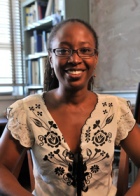About

Ayana Arce
Infinitesimal Collisions, Fundamental Insights
Ayana Arce CEF ’12 describes current work on the Higgs boson
For many non-scientists, the 2012 discovery of what might be the Higgs boson was mysterious enough. Since 1964, high-energy physicists had sought to prove the existence of this elementary particle that might give mass to other particles, but the general public was little aware of the drama of the search. The hypothetical boson’s unfortunate and misleading nickname—“the God particle”— only added to the confusion.
So what could it mean to learn, as scientists at CERN’s Large Hadron Collider in Switzerland told the media in March 2013, that the vaunted new discovery might in fact not be the Higgs boson, but a Higgs boson, among other similar particles?
Ayana Arce CEF ’12, an assistant professor of physics at Duke University, works with the ATLAS detector at the Large Hadron Collider (LHC). The Higgs discovery, she explains, neither fully proves nor disproves what’s called the Standard Model, physics’ basic but incomplete list of known types of matter and interactive forces. Alternative theories, such as supersymmetry, have been proposed to encompass some phenomena—such as dark matter—that the Standard Model can’t address.
“The issue is that because these theories must introduce new kinds of matter, the simplest Higgs mechanism, in which one particle interacts with every kind of matter particle to generate its mass, doesn’t necessarily work. To use the Higgs mechanism to explain particle masses, these kinds of theories must introduce new Higgs particles along with the extra matter particles they predict.” Hence, the recently confirmed Higgs boson may turn out to be one of many.
Noting that physicists are very careful with language when they present findings conservatively, she adds, “The simplest answer is not always the final answer, and nothing forbids distinct Higgs fields from giving mass to different particles, so we have started emphasizing this fact by calling it ‘a Higgs boson.’ If we can prove that this particle has the expected interactions with most of the known matter particles—and if we don’t discover supersymmetry in the meantime—perhaps we will start saying ‘the Higgs boson’ again.”
Planned upgrades to the LHC, Dr. Arce says, will reveal still more about the essence of matter—but the collider enhancements needed to produce different particles and interactions would soon saturate some of the existing detectors and software. Her current work focuses on creating both new detectors and new ways of assessing what they will reveal. “These collisions [produced by LHC upgrades] will include processes that have never before been observed in a laboratory. By increasing the frequency of proton collisions we will have better chances of studying these rare events, which might include very massive new particles.”
The daughter of a computer scientist and a professor of English and law—both on the Duke faculty—Dr. Arce was fascinated early on by the smallest components of matter. A writing assignment, she recalls, led her to particle physics. “In a high school math class, every student had to do a written report on the practical applications of vectors, and somehow I ended up reading and writing about polarization vectors and quantum electrodynamics. The fact that electrons didn’t act like normal ‘stuff’ fascinated me. Today, I mostly remember the assignment because it was the only research paper I ever did for a math class, and because it led more than one student in that class to her eventual scientific career.”
Early in her career, Dr. Arce has already participated in several projects designed to bring high-energy physics to the public and to K-12 audiences, and has taken part in national panels on engaging more women and people of color in scientific careers. “I focus on the known ways to make careers in science more accessible to students who already think they might like it,” she says, rather than on trying to convince those with other interests to consider science.
To make science careers more accessible, Dr. Arce adds, not only do reviewers, counselors, and teachers need to cultivate talent without bias, but “we need to take steps to reduce the obstacles that students face by virtue of being different from the perceived norm. Studies point to mentoring and role-models, as well as creating networks for students, as useful tools for doing this.”
See Dr. Arce in a video on the Large Hadron Collider. She also explains fundamental particle interactions for Annenberg Learner in a video here.

